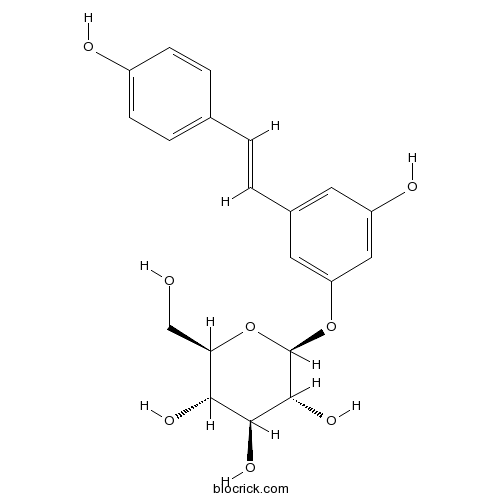Lysidice brevicalyx
Lysidice brevicalyx
1. The products in our compound library are selected from thousands of unique natural products; 2. It has the characteristics of diverse structure, diverse sources and wide coverage of activities; 3. Provide information on the activity of products from major journals, patents and research reports around the world, providing theoretical direction and research basis for further research and screening; 4. Free combination according to the type, source, target and disease of natural product; 5. The compound powder is placed in a covered tube and then discharged into a 10 x 10 cryostat; 6. Transport in ice pack or dry ice pack. Please store it at -20 °C as soon as possible after receiving the product, and use it as soon as possible after opening.
Natural products/compounds from Lysidice brevicalyx
- Cat.No. Product Name CAS Number COA
-
BCN5949
Polydatin27208-80-6
Instructions

Phenolic glycosides isolated from the bark of Lysidice brevicalyx Wei.[Pubmed: 20552492]
Two new compounds, lysidiside S (1) and 7-O-(+)-peltogynol-beta-d-glucopyranoside (2), together with six known phenolic glycosides (3-8) were isolated from the bark of Lysidice brevicalyx Wei. The structures of these compounds were characterized by chemical and spectroscopic methods. The antioxidant activities of compounds 1-8 were evaluated, and compound 3 exhibited remarkable antioxidant activity at concentrations of 10(-4), 10(-5), and 10(-6) mol/l.
Structural characterization of trace stilbene glycosides in Lysidice brevicalyx Wei using liquid chromatography/diode-array detection/electrospray ionization tandem mass spectrometry.[Pubmed: 19945362]
The mass fragmentation patterns of stilbene glycosides isolated from the genus Lysidice were investigated by negative ion electrospray ionization tandem mass spectrometry, and the influence of collision energy on their fragmentation behavior is discussed. It is found that the presence of the Y(0)(-) and B(0)(-) ions in the MS(2) spectra is characteristic for 1-->6 linked diglycosyl stilbenes, while the Y(0)(-), Y(1)(-), and Z(1)(-) ions are representative ions of 1-->2 linked diglycosyl stilbenes. These results indicate that ESI-MS(n) in the negative ion mode can be used to differentiate 1-->6 and 1-->2 linked diglycosyl stilbenes. Based on the fragmentation rules, 9 new trace constituents were identified or tentatively characterized in a fraction of Lysidice brevicalyx by using HPLC/HRMS and HPLC-DAD/ESI-MS(n). The results of the present study can assist in on-line structural identification of analogous constituents and targeted isolation of novel compounds from crude plant extracts.
[Studies on chemical constituents from leaves of Lysidice brevicalyx].[Pubmed: 19216159]
To study the chemical constituents of Lysidice brevicalyx.
Targeted isolation and structure elucidation of stilbene glycosides from the bark of Lysidice brevicalyx Wei guided by biological and chemical screening.[Pubmed: 18847246]
An efficient procedure based on biological and chemical screening has been performed to investigate the antioxidant constituents of the bark of Lysidice brevicalyx Wei. The procedure allowed the rapid identification of known compounds and tentative characterization of unknown compounds by online LC/UV/ESIMS(n) analyses of the antioxidant fraction. Targeted isolation of the unknown compounds has led to the discovery of seven new stilbene glycosides, named lysidisides L-R (1-7), together with a known stilbene glycoside, (E)-resveratrol 3-O-rutinoside (8). The structures of these compounds were further determined on the basis of spectroscopic and chemical evidence. The antioxidant activities of compounds 1-8 and two related compounds, (E)-polydatin (9) and lysidiside E (11), were evaluated. The known compound (E)-polydatin (9) showed antioxidant activity at concentrations of 10(-4) and 10(-5) mol/L.
Structural characterization of constituents with molecular diversity in fractions from Lysidice brevicalyx by liquid chromatography/diode-array detection/electrospray ionization tandem mass spectrometry and liquid chromatography/nuclear magnetic resonance.[Pubmed: 18288769]
A combination of electrospray ionization tandem mass spectrometry with high-performance liquid chromatography (HPLC/ESI-MSn), and hyphenation of liquid chromatography to nuclear magnetic resonance spectroscopy (HPLC/NMR), have been extensively utilized for on-line analysis of natural products, analyzing metabolite and drug impurity. In our last paper, we reported an on-line analytical method for structural identification of trace alkaloids in the same class. However, the structural types of the constituents in plants were various, such as flavanoids, terpenoids and steroids. It is important to establish an effective analytical method for on-line structural identification of constituents with molecular diversity in extracts of plants. So, in the present study, the fragmentation patterns of some isolated stilbenes, phloroglucinols and flavanoids from Lysidice rhodostegia were investigated by ESI-MSn. Their fragmentation rules and UV characteristics are summarized, and the relationship between the spectral characteristics, rules and the structures is described. According to the fragmentation rules, NMR and UV spectral characteristics, 24 constituents of different types in the fractions from L. brevicalyx of the same genus were structurally characterized on the basis of HPLC/HRMS, HPLC-UV/ESI-MSn, HPLC/1H NMR and HPLC/1H-1H COSY rapidly. Of these, six (10, 13, 14, 16, 17 and 23) are new compounds and all of them are reported from L. brevicalyx for the first time. The aim is to develop an effective analytical method for on-line structural identification of natural products with molecular diversity in plants, and to guide the rapid and direct isolation of novel compounds by chemical screening.


